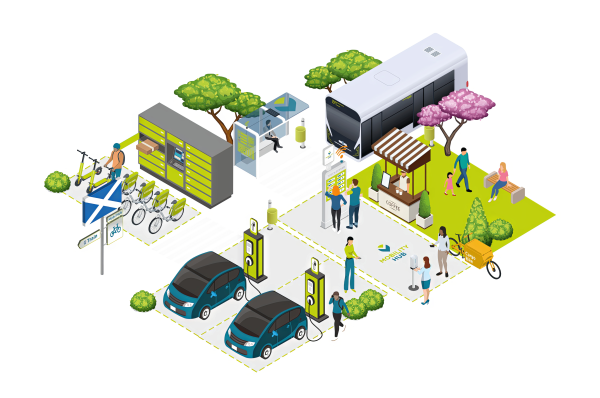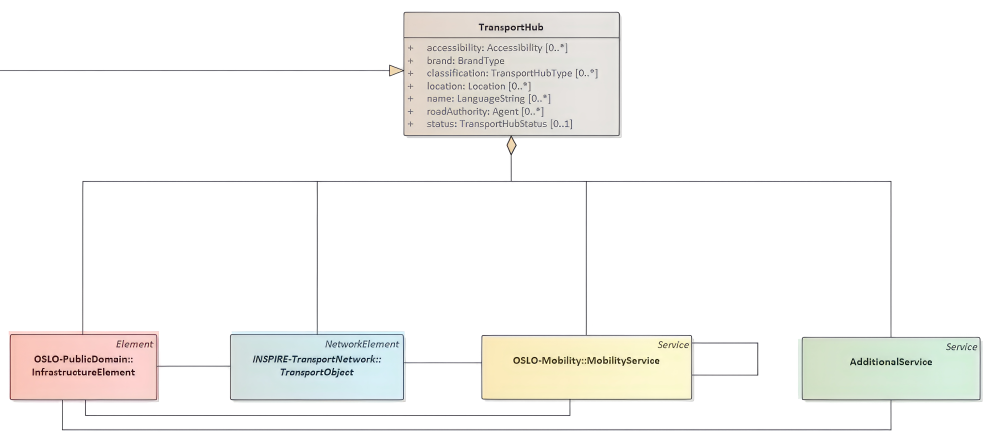
Boost modal shift by improving the passenger experience
We can boost the use of public transportation in combination with other mobility services (like shared bikes) by improving the user experience at passenger transport hubs. Using forecasting and real-time information about mobility solutions, together with service information, users can better plan their train and bike journeys. This reduces waiting time at transport hubs and avoids the non-availability of resources such as shared bikes.
In co-creation with academia, the public and the private sector, we developed a semantic data model for Passenger Transport Hubs to support data sharing between (mobility) service providers to make creating the above solutions easier.
What is a passenger transport hub?
You can quickly transfer transport means at a passenger transport hub. Depending on the area, you will find trains, trams, busses, taxis, shared cars, shared (e-)bikes, e-steps, a Park & Ride zone, bicycle parking spaces, etc. These modes of transport are coordinated and supplemented with additional services (e.g. bike maintenance gear, e-charging points, parcel lockers, coffee and other shops).
Co-creation process
Ten partners from the public and the private sector and academia from Spain, France and Belgium developed the OSLO Passenger Transport Hubs vocabulary and application profile. The business requirements were gathered during a workshop. Some examples of use cases:
- A person planning to go to a concert in another city wants to know if he/she will be able to take a shared bike at the arrival train station or should calculate the time to walk to the venue and take a train earlier
- A person in a wheelchair wants to know if at a specific passenger transport hub the train company offers help to board a train and how accessible the passenger transport hub is from the taxi stop place to the train platform
In open thematic workshops, domain experts reached semantic agreements starting from existing international standards, vocabularies and datasets in the European Data Portal. These working groups followed the process and method within a formal governance framework.

OSLO standardisation process and approach
OSLO is the interoperability program in the region of Flanders, which brings together expertise from different business domains and governmental levels, independent of specific thematic use cases. The Flemish Government developed several domain models in line with international standards, including Interoperable Europe (ISA²) and INSPIRE, enriched by data extensions to comply with the local (European) context. The formal specification is published at https://data.vlaanderen.be/ or https://purl.eu/. The thematic working groups, with over 500 authors from the public sector, private sector and academia, demonstrated that it is possible to raise interoperability and foster data harmonisation from different use cases.
Fundamentals of the OSLO Passenger Transport Hubs vocabulary and application profile
The co-creation process resulted in the following open and reusable standards:
A vocabulary is a collection of reusable terms, more precisely classes and properties, of which their semantics are fixed using a label and a definition. The application profile indicates how words from the related vocabulary are used to exchange data on Transport Hubs for passengers.
The model consists of two parts. The first part defines a Transport Hub and describes its related elements, explicitly focusing on passenger transport. The second part focuses on the traveller using Transport Hubs for his journey or route. Below we focus on part one. For more info on part two, we refer to the application profile OSLO Mobility: Trips and Offerings
An OSLO Transport Hub consist of:
- InfrastructureElements
- TransportNetworks
- MobilityServices
- AdditionalServices

The main class TransportHub has the following properties: accessibility, brand, classification, infrastructureElement, location, roadAuthority, service, service, status, title, transportObject.
The InfrastructureElements represent the physical aspect of a Transport Hub; it concerns objects such as Information columns, Stopplaces, Parkings, Bicycle racks, Chargers etc. which are necessary for the connected Transport networks and the services offered at the Transport Hubs.
The TransportNetworks available at a Transport Hub are accessible via TransportObjects such as TransportNodes (stops, stations... ) and TransportConnections between those nodes. Also, VirtualNodes (points located on a link between two Transport Nodes, e.g. the position of an abandoned shared step within a city) are possible. –
MobilityServices are available at the Transport Hub. These can be scheduled services or shared steps, but just as well as parking spaces or bicycle pumps.
At a TransportHub, we also usually find all kinds of AdditionalServices, including services that save the traveler, additional trips such as mailboxes, bakeries, newspaper stores, etc.
Enumerations are basically described outside the application profile; hence the enumeration values shown in the diagram are illustrative.